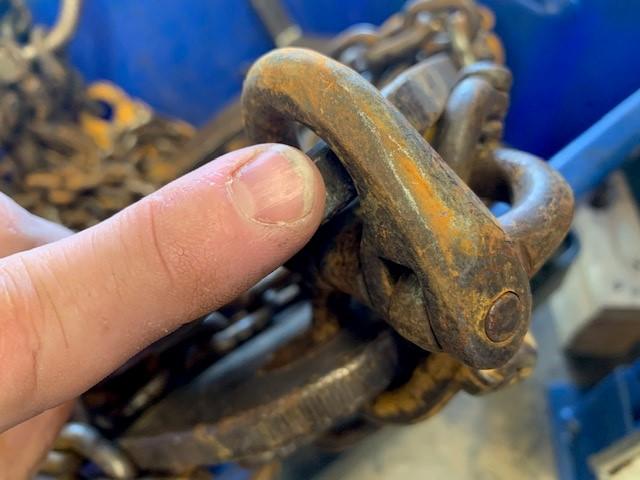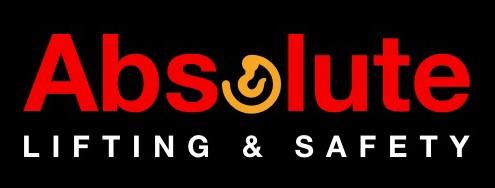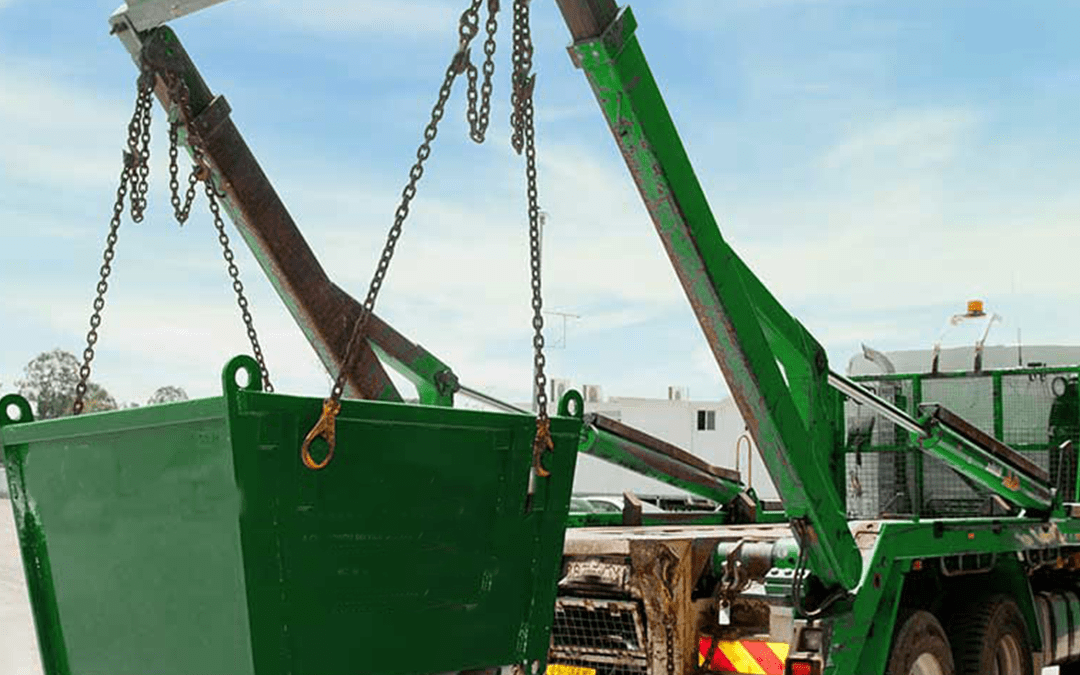Regular Inspection of Skip Bin Chains and Components are paramount in the safety of workers, bi-standers, plant and machinery.
Skip bin trucks are specialized vehicles that are designed to transport and dispose of large quantities of waste material. These trucks are commonly used by construction companies, demolition crews, and other businesses that generate significant amounts of waste as part of their operations.
One of the most important components of skip bin trucks is the chain system that is used to secure the bins during transport. These chains are typically made from high-strength steel and are designed to withstand the weight and pressure of loaded bins.
Ensuring the safety of the chain system and other components of skip bin trucks should be a top priority for anyone operating these vehicles. Regular inspection and maintenance of the chains and components are crucial to ensure that they are in good working condition and free from defects or damage. Any damaged or worn out chains or components should be replaced immediately to prevent potential accidents.
The chain system of skip bin trucks consists of several components, including the chains themselves, hooks, and connecting links, also known as hammerlocks. The chains are attached to the bin at several points, and the hooks are used to secure the chains to the truck.
In summary, skip bin trucks are an essential tool for businesses that generate large amounts of waste. The chain system used to secure the bins during transport is a critical component of these vehicles, and proper maintenance and inspection are necessary to ensure safe operation. Regular inspection and replacement of damaged or worn out chains and components will help ensure the safety of the truck operator and other individuals in the vicinity.
About the chain system securing the bin during lifting and operation and common issues with components
Skip Bin Chains
Chains play a crucial role in securing the bin with skip bin trucks during transport. The chain system is used to ensure that the waste container remains in place while the truck is in motion. They are designed to withstand the weight and pressure of loaded bins.
The chains are attached to the bin at several points, and the hooks are used to secure the chains to the truck. The chain system also prevents the bin from tipping over or sliding off the truck, which could cause damage or injury.
It is important to ensure that the chains are properly maintained and inspected regularly to ensure that they are in good working condition. Any damaged or worn out chains or components should be replaced immediately to prevent potential accidents.
In summary, the chain system is a critical component of skip bin trucks that is responsible for securing the bin during transport. Proper maintenance and inspection of the chains are essential to ensure the safety of the truck operator and other individuals in the vicinity. The chain system ensures that the bin remains in place and prevents it from tipping over or sliding off the truck, which could cause damage or injury.
Common issues with Chains
- Exposure to weather, or contact with debris. Worn or damaged links can weaken the chain and cause it to fail, resulting in potential safety hazards. Inspect the chain for any visible signs of wear, such as cracks or deformities, and replace any damaged links immediately.
- Rust or Corrosion: Exposure to weather, moisture, or chemicals can cause the chain to rust or corrode, leading to weakened links and potential safety hazards. Inspect the chain regularly for signs of rust or corrosion, and clean the chain as necessary to prevent further damage.
- Overloading: Lifting chains are designed to withstand a specific weight capacity. Overloading the chain beyond its capacity can cause it to fail, resulting in potential safety hazards. Ensure that the weight of the waste container does not exceed the chain’s capacity, and do not use the chain to lift anything other than the waste container. To size the correct chain and fittings you can refer to our working load limit chart.
- Improper Storage: Lifting chains should be stored in a dry, clean area to prevent damage from exposure to moisture or debris. Improper storage can lead to weakened links and potential safety hazards. Store the chain in a secure location and inspect it regularly to ensure that it is in good working condition.
In summary, lifting chains are an essential component of skip bin trucks and require regular inspection and maintenance to ensure safe operation. Look out for signs of wear and tear, rust or corrosion, overloading, and improper storage. Replace any damaged or worn-out links immediately, and store the chain properly to prevent potential safety hazards.
What is the role of Hammerlocks or Connecting Links?
Hammerlocks are designed to create a secure, permanent connection between two pieces of chain. They are typically made from high-strength steel and are designed to withstand heavy loads and harsh environments.
Hammerlocks are commonly used in lifting and rigging applications such as chain slings, wire rope slings, and other types of load-bearing structures. They are often used in combination with other rigging components such as hooks, shackles, and turnbuckles to create secure and reliable lifting and hauling systems.
It’s important to note that hammerlocks are considered to be a permanent connection, and should not be opened or reused once they have been closed. Any hammerlock that has been opened or shows signs of wear or damage should be replaced to ensure safe and reliable operation.
A common issue with Hammerlocks on Chains with Skip bins.
The swivel component allows to reduce stress on the Hammerlock becomes stuck.
Many reasons can cause the Hammerlock to become stick : –
- Corrosion: Over time, exposure to moisture, salt, and other environmental factors can cause corrosion to develop on the metal components of the hammerlock. This can cause the swivel component to become seized, making it difficult or impossible to rotate.
- Overloading: If the swivel hammerlock is used to secure a load that exceeds its weight capacity, this can cause the swivel to become stuck due to the excessive force applied to the components.
- Misalignment: If the swivel hammerlock is not properly aligned when it is installed, it can become stuck as the swivel component is forced to rotate in a direction that is not aligned with the load.
- Debris: Dirt, dust, and other debris can accumulate in the swivel mechanism over time, making it difficult to rotate.
To prevent swivel hammerlocks from becoming stuck, it’s important to ensure that they are properly installed and used within their working load limit. Regular inspections and maintenance can also help to identify any signs of corrosion, misalignment, or other issues that could cause the swivel to become stuck. If the swivel hammerlock does become stuck, it should not be forced to rotate, as this can cause further damage to the components. Instead, a competent person should be consulted to safely address the issue.
Safety Hooks
Safety hooks are a crucial component of the chain system used to secure the bin with skip bin trucks. They are designed to prevent the chains from accidentally becoming detached from the truck or the bin, which could cause the waste container to fall or shift during transport, leading to potential safety hazards.
The safety hooks are typically made of high-strength steel and are designed to withstand the weight and pressure of loaded bins. They are installed at the ends of the chains and are used to connect the chains to the truck and the bin. The safety hooks are designed to lock securely into place, ensuring that the chains remain attached and prevent the waste container from accidentally becoming detached.
In addition to securing the bin during transport, safety hooks also make it easier to connect and disconnect the chains from the truck and the bin. They allow for quick and efficient attachment and detachment, saving time and reducing the risk of injury to the operator.
In summary, safety hooks play a critical role in ensuring the safe operation of skip bin trucks. They prevent the chains from becoming detached during transport and make it easier to connect and disconnect the chains from the truck and the bin. The use of safety hooks is essential for the safe and efficient operation of skip bin trucks.
Absolute Lifting and Safety recommends using Grade 80 eye swivel self-lock hooks with ball bearings for optimal safety when securing the skip bins.
Why do we recommend using Swivel hooks with ball bearings ?
Swivel hooks with ball bearings are a type of lifting hook that is commonly used in skip bin trucks to secure the waste container during transport. These hooks offer several benefits over traditional hooks, including:
- Improved Safety: Swivel hooks with ball bearings offer improved safety during transport. The ball bearings allow the hook to rotate freely, which helps to prevent the chain from becoming twisted or tangled. This reduces the risk of the chain breaking or becoming detached from the truck or bin, which could cause the waste container to fall or shift during transport, leading to potential safety hazards.
- Increased Efficiency: Swivel hooks with ball bearings are designed to rotate freely, making it easier to connect and disconnect the chains from the truck and the bin. This improves efficiency and reduces the time it takes to secure the waste container during transport.
- Reduced Wear and Tear: Swivel hooks with ball bearings help to reduce wear and tear on the chains and other components of the chain system. The ball bearings allow the chain to rotate freely, reducing the amount of stress and strain placed on the chain during transport. This can help to extend the lifespan of the chain and other components of the chain system.
- Versatility: Swivel hooks with ball bearings are versatile and can be used with a wide range of chain sizes and types. This makes them an ideal choice for skip bin trucks and other applications that require lifting hooks.
In summary, swivel hooks with ball bearings offer several benefits over traditional hooks, including improved safety, increased efficiency, reduced wear and tear, and versatility. The use of swivel hooks with ball bearings is an excellent way to improve the safety and efficiency of skip bin trucks and other applications that require lifting hooks.
What to look out for inspecting the hooks ?
If the latch on a Grade 80 eye swivel self-lock hook with a ball bearing is stuck, there are several steps you can take to try and release it:
- Clean the hook: Dirt, dust, and other debris can accumulate in the latch mechanism, making it difficult to open. Use a soft-bristled brush to clean any dirt or debris from the latch, and then try to open it again.
- Apply lubricant: Apply a small amount of lubricant to the latch mechanism to help loosen any corrosion or rust that may be causing it to stick. Use a lubricant that is appropriate for the material of the hook and latch, and be sure to wipe away any excess lubricant.
- Use a tool: If the latch is still stuck, you can try using a pair of pliers or another tool to gently pry it open. Be careful not to apply too much force, as this could damage the latch or the hook.
- Seek professional help: If the latch is still stuck or you are unsure of how to safely release it, it’s best to seek the help of a qualified professional, such as a rigging technician or a representative from the hook manufacturer. They can help identify the cause of the problem and safely release the latch without causing further damage to the hook or the load it is securing.
It’s important to keep in mind that a stuck latch on a hook can compromise its safety and reliability, so it’s crucial to address the issue promptly and safely before continuing to use the hook.
In the below example the hook’s latch has been placed under excessive force causing the latch to bend. This hook should be immediately removed from service.

Degraded components can reduce the working load capacity to cause a catastrophic failure.
Degraded Hooks, Connecting Links, Chains and Shackles
Wear and tear: With regular use, hooks can become worn or damaged, particularly in areas that experience high levels of stress or abrasion. Over time, this wear can weaken the hook and reduce its load capacity.
- Corrosion: Exposure to moisture, salt, and other environmental factors can cause corrosion to develop on the surface of the hook. This can weaken the metal and make it more susceptible to cracking or failure.
- Overloading: If a hook is used to lift or secure a load that exceeds its weight capacity, it can become overloaded and stressed beyond its limits. This can cause the hook to deform or fail, which can result in catastrophic failure and serious injury or damage.
- Improper use: If a hook is used improperly, such as by using it to lift a load from the tip of the hook rather than the base, this can cause excessive stress and wear on the hook.
- Lack of maintenance: Regular inspections and maintenance are essential for identifying any signs of wear, corrosion, or damage that could compromise the safety and reliability of the hook. Without proper maintenance, these issues can go unnoticed and lead to failure.
It’s important to regularly inspect hooks for signs of wear or damage, and to replace any hooks that show signs of degradation or that have been overloaded. Using hooks within their weight capacity and following proper rigging procedures can also help to reduce the risk of degradation and failure.
In the below picture the connecting link should immediately be removed from service due to wear exceeding 10% of its original material thickness. The link has proven to also sustain a permanent set of more than 1% of its original dimension .
What is permanent set deformation ? Read more

Shackles
Shackles are an essential component of the chain system used to secure the bin with skip bin trucks. They are used to connect the chains to the bin and the truck and are typically made from high-strength steel.
Shackles are used to provide a secure attachment point for the chains and other components of the chain system. They are used to connect the chains to the bin and the truck, allowing for the secure transport of the waste container.
There are several different types of shackles that are commonly used in skip bin trucks, including anchor shackles, chain shackles, and D shackles. The type of shackle used will depend on the specific application and the size and weight of the waste container.
Shackles are designed to withstand the weight and pressure of loaded bins and are typically tested to ensure they meet specific strength and safety standards. It is essential to inspect the shackles regularly to ensure they are in good working condition and free from any defects or damage. Any damaged or worn out shackles should be replaced immediately to prevent potential accidents.
In summary, shackles are a crucial component of the chain system used to secure the bin with skip bin trucks. They provide a secure attachment point for the chains and other components of the chain system, allowing for the safe and efficient transport of the waste container. It is important to inspect and maintain shackles regularly to ensure they are in good working condition and to prevent potential accidents.
Improper use of Shackle
- Improper use: If a shackle is used improperly, such as by using it to lift a load from the tip rather than the base, this can cause excessive stress and wear on the shackle. To avoid lifting a load from the tip, it’s important to identify the center of gravity of the load and to use lifting devices that allow the load to be lifted from a point closer to the center of gravity. This will help to distribute the weight of the load more evenly across the lifting device and reduce the risk of deformation or failure. It’s also important to follow proper rigging procedures and to use lifting devices within their weight capacity to ensure safe lifting operations.
Lifting a load from the tip can create a dangerous situation because the load is not evenly distributed across the lifting device. This can result in uneven stress and tension on the lifting device and can cause it to deform or fail. In addition, lifting from the tip can cause the load to become unstable, increasing the risk of the load shifting or falling.
To avoid lifting a load from the tip, it’s important to identify the center of gravity of the load and to use lifting devices that allow the load to be lifted from a point closer to the center of gravity. This will help to distribute the weight of the load more evenly across the lifting device and reduce the risk of deformation or failure. It’s also important to follow proper rigging procedures and to use lifting devices within their weight capacity to ensure safe lifting operations.
2. Pin failure: The pin used to secure the shackle can also fail, either due to corrosion or deformation. If the pin fails, the shackle can become detached from the load, which can result in serious injury or damage.

